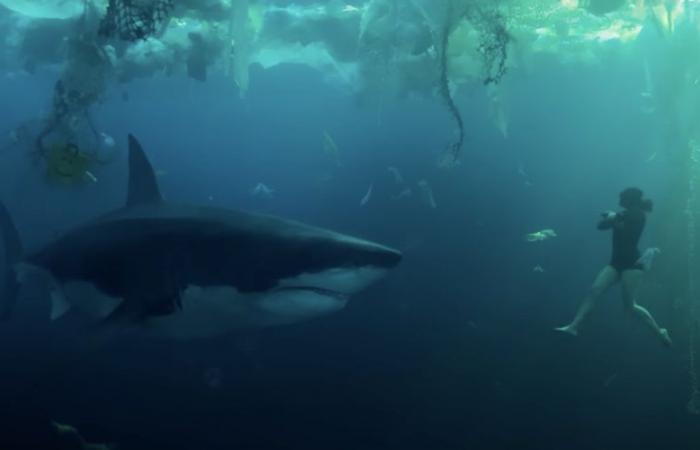
In Sous la Seine, released on Netflix this June 5, a mako shark, lost in this river, terrorizes the city of Paris during a swimming event. So, improbable or plausible scenario? The founder of the Phocéen Shark Study Group (GPER Marseille), Nicolas Ziani, debunks the successful film (or nanar, your choice).
Since its release on Netflix on June 5, the French film Under the Seine is a hit around the world, as evidenced by its official figures published on June 12.
A “monster” success
With its 40.9 million views in just five days, the feature film by Xavier Gens, director of Border(s) And Hitman among others, became the most watched non-English film around the world. Under the Seine thus steals 1st place from the Japanese Godzilla Minus One which accumulates 31 million hours viewed.
To this day, the film is still in the Top 10 most watched foreign films in 93 countries around the world. Under Paris (name of the film abroad), even occupies 1st place in 76 of these countries.
Given its success, Under the Seine could even be entitled to a sequel. Asked by nice morningXavier Gens, its director, does not exclude the possibility of a second opus: “For me, there may then be other sharks in other major cities in the world” he confided.
In Xavier Gens’ feature film, a scientist (Bérénice Bejo) and a river police brigadier (Nassim Lyes) try to stop a shark sowing terror in the Seine in Paris during a triathlon event.
A film that “makes people laugh more than inspire fear”
“A cinematic delirium” for Nicolas Ziani, founder of the Phocaean Shark Study Group (GPER Marseille). If the film, inspired by the unbeatable Jaws by Steven Spielberg, is dubbed by Anglo-Saxon critics, in France it is not the case.
“Spielberg’s film is based on real events that happened in New Jersey. Situationally and geographically it is much more coherent than putting sharks in the Seine.”
For the specialist and the numerous French critics, the film “makes you laugh more than inspire fear” and moves significantly away from scientific reality. And this, despite the numerous details brought by its director to give it authenticity: a triathlon event which is furiously reminiscent of that of the Olympic Games in the Seine this summer, the reference to the beluga and the orca or even the shells in the river…
“What would he do in the Seine?”
Yet we would almost like to believe in this improbable scenario: a new ultra-aggressive super-species of shark which evolves very quickly because of pollution and climate change and which finds itself colonizing Paris and then the world. The movie with Jason Statham fighting a megalodon (In troubled waters) came from the depths “is almost more coherent”indicates the specialist in marine ichthyology.
Under the Seine “is a bad education in science” which feeds the “formatted speeches and the collective imagination” around sharks. First, because the feature film by Xavier Gens “Lends psychopathic animosities which have no place in a shark. It’s very anthropomorphic (tendency to attribute human reactions to animals and things, editor’s note)“explains Nicolas Ziani.
And even if it would be possible for a shark to be adapted to fresh water, the choice of the mako shark for the film is a mistake: “The only species that we could see in fresh water is the bull shark, at the limit. But what would it do in the Seine when this is not its biotope” ?, protests the specialist.
“Z-series Nanar in which nothing is rational”
The same goes for parthenogenesis (reproduction without fertilization by a male) which characterizes the shark in the French feature film: “We observed parthenogenesis in sharks in aquariums. What is wrong with the film is that there was no expertise. Jaws, the director called on biologists. This is what gives the realistic side, not like Under the SeineZ-series nonsense in which nothing is rational.”
In addition, the shark presented in the feature film measures around 7 meters in length (at the start of the film). Mathematically speaking, he could neither have passed through the locks, nor moved and lived in the Parisian river, the depth of which varies between 3.40 and 5.70 m. And even less pass the Palavas-les-Flots estuary to join the Lez in Montpellier which has a flow of 2.55 m3/s.
And in several thousand years, if pollution and climate change have worsened? “No more. And even if there were species migrations or a climatic catastrophe, I find the scenario crazy and the film far-fetched”, replies the specialist. Little chance then, in the coming decades, of coming across a murderous shark in a river. Even less in Lez in Montpellier.
“It is the scientists, after all, who have the knowledge of what is happening”
If Xavier Gens felt he had “a documentary approach” and delivered an ecological message which makes us believe in his film, this is not the case for Nicolas Ziani, founder of the Phocaean Shark Study Group (GPER Marseille). While he compares the French feature film to a “science fiction madness”it also underlines the side “alarmist and extremist” from his message: “I am not OK with this extremist ecology and often lacking in terms of information, like the Sea Shepherd, which appeals to popular ecology.”
If the specialist actually considers that the cause of sharks is “scientifically worrying”he points out the sectarianism sometimes adopted by extremist ecology: “It is the scientists, after all, who have the knowledge about what is happening. The other organizations and associations only mediate, and often, there is a lot of cognitive bias in their information”explains the specialist.





